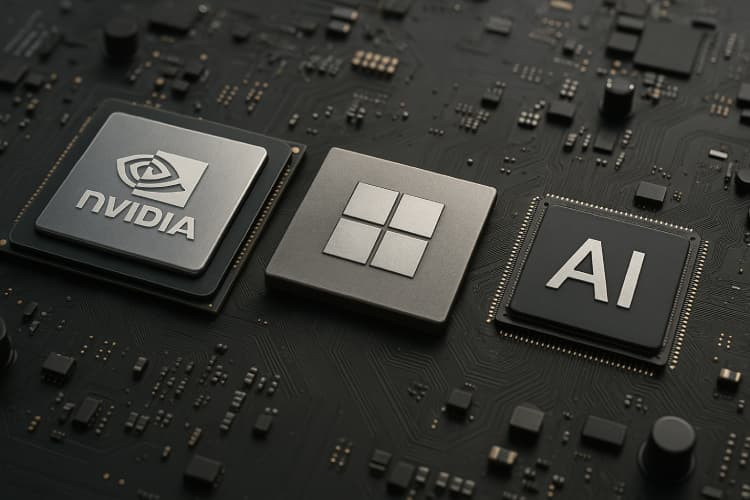NVIDIA vs Microsoft in AI Race to $5 Trillion Valuation
Insights | 15-07-2025 | By Robin Mitchell

Key Things to Know:
- NVIDIA surpasses $4T valuation, leading global AI infrastructure with datacenter-grade GPUs and a closed-loop development ecosystem.
- Microsoft reaches $3.75T by embedding AI into its software suite—Copilot, Teams, GitHub—making AI adoption seamless for enterprises.
- AI market leadership is driven by scalable infrastructure and integration, not hype—hardware by NVIDIA, enterprise software by Microsoft.
- Geopolitics and regulation are emerging as key risks to future growth, especially for hardware exports and AI policy enforcement.
As AI accelerates into every layer of modern infrastructure, two companies have emerged as architects of this transformation, each from a different front. Microsoft and NVIDIA have not simply followed the AI trend; they have defined it, embedding themselves into the core of how intelligence is developed, deployed, and monetised. Now, with NVIDIA breaking the $4 trillion barrier and Microsoft approaching $3.75 trillion, the spotlight is firmly on how these tech giants reached such towering valuations.
What strategies did they pursue, how did their distinct approaches shape the AI economy, and what does their dual dominance reveal about the future of scalable, monetisable AI platforms?
How NVIDIA and Microsoft Rose to Become the World's Most Valuable Companies
In an industry often swayed by hype cycles and short-term trends, it is uncommon for two companies to establish long-term market dominance through distinctly different yet equally strategic approaches. Microsoft and NVIDIA have achieved precisely that, not through chance, but by securing their positions as foundational players in the infrastructure of the AI era.
Microsoft's rise was not the result of trend-chasing. It stemmed from a clear understanding of where enterprise technology was headed: toward cloud-native platforms, subscription-based services, and deeply integrated AI solutions. While Google concentrated on consumer hardware and Amazon focused on retail infrastructure, Microsoft methodically transformed Azure into a cloud computing powerhouse.
The company's landmark $10 billion investment in OpenAI was more than a symbolic gesture. It marked a decisive move to embed AI into the core of Microsoft's product ecosystem: Office, Teams, GitHub Copilot, and Windows. This wasn't AI positioned as an optional add-on; it became the default interface for modern productivity. As a result, enterprise adoption was frictionless. CIOs didn't have to justify adopting AI because it was already embedded in the tools they were using.
Crucially, Microsoft demonstrated an ability to monetise AI at scale. Unlike many peers that focus on showcasing technical capabilities, Microsoft delivered integrated, compliant, and scalable solutions that enterprises could deploy with confidence.
From Software Integration to Hardware Domination
While Microsoft was redefining enterprise software, NVIDIA was quietly securing dominance over the hardware stack. Its strategy extended well beyond selling GPUs; it built a complete ecosystem. With the CUDA platform becoming the de facto standard for AI development, NVIDIA entrenched itself in every layer of the machine learning pipeline. From academic labs to Fortune 500 companies, developers trained their models on NVIDIA silicon.
As generative AI scaled rapidly, most competitors were caught in the design or fabrication stages. NVIDIA, on the other hand, already has high-performance, datacenter-grade GPUs in production and demand. The company didn't just benefit from AI growth; it enabled it.
NVIDIA also expanded its competitive moat through its software ecosystem, including TensorRT, DGX systems, and proprietary AI libraries. This holistic integration created a closed-loop platform focused on performance, efficiency, and scalability. Buying an NVIDIA GPU increasingly meant adopting a broader NVIDIA workflow.
The result is a structural shift in computing architecture. Data centers are now being designed around NVIDIA hardware, rather than traditional CPUs. The market has responded accordingly.
Both Microsoft and NVIDIA recognised early that AI, cloud computing, and edge intelligence would define the next generation of technology. Rather than competing for consumer attention, they captured the foundation: compute, storage, code, and deployment.
In contrast, legacy players such as Meta, Intel, and IBM either pursued misaligned strategies or failed to scale effectively. Google, despite early leadership in AI research, struggled to commercialise its innovations at Microsoft's level. Apple, while dominant in hardware, has yet to establish a leadership role in AI infrastructure or services.
NVIDIA Breaks $4T Barrier, Microsoft Dominates Enterprise AI
With the AI race intensifying, NVIDIA has officially surpassed a $4.02 trillion market cap, becoming the world's most valuable company. Microsoft, now at approximately $3.74 trillion, remains a dominant force in enterprise AI. Their paths illustrate not only where value is being created in AI, but also how that value is being captured.
NVIDIA's rise has been meteoric. From a $360 billion valuation in 2022, the company had grown to over $4 trillion by mid-2025, cementing its role as the backbone of AI compute infrastructure. The catalyst: AI infrastructure. Unlike past valuation booms driven by social media or smartphones, NVIDIA's surge is rooted in silicon, the high-performance GPUs powering virtually every major AI model, from ChatGPT to autonomous driving systems.
This hardware-centric growth model is unique. NVIDIA doesn't just sell chips; it sells the ability to train and deploy the next generation of AI. It owns the foundation. With global demand for AI compute reaching unprecedented levels, NVIDIA's dominance has rewritten the traditional playbook on tech valuations.
Around 25% of NVIDIA's data centre revenue still originates from China, but U.S. export restrictions have intensified. The H20 GPU is now subject to licensing constraints, and NVIDIA has developed reduced-performance versions of its Blackwell chips to remain compliant.
As of mid-2025, U.S. restrictions on advanced GPU exports continue to tighten. The Commerce Department's limits on China-bound AI chips—including performance caps on the H20 and reduced-core Blackwell variants—pose ongoing uncertainty for NVIDIA's international revenue mix.
Geopolitics, Not Competitors, Threaten NVIDIA’s Trajectory
Geopolitical tension, more than direct competition, poses the greatest near-term risk to its revenue momentum. In short, geopolitical factors, not competitors, may be NVIDIA's biggest obstacle to the $4 trillion mark.
While NVIDIA powers the compute infrastructure, Microsoft monetises AI across the software stack. With Azure now integrated with OpenAI models, and tools like Copilot, Teams, and Office AI-native by default, Microsoft remains the enterprise leader in applied AI. However, the company now faces growing competition from Google and Amazon, both of which have significantly intensified their AI offerings. Google Cloud has embedded Gemini models across Workspace and GCP services, while Amazon Web Services has expanded Bedrock's generative AI tooling for developers, aiming to erode Microsoft's early enterprise lead, as hyperscalers race to embed generative models into their own cloud ecosystems.
Rather than building chips, Microsoft embeds AI into existing products. GitHub Copilot, Office 365, Teams, Dynamics—everywhere Microsoft software goes, AI goes with it. CIOs aren't deciding whether to adopt AI. They're already paying for it as part of their software suite.
This approach is sticky, scalable, and hard to displace. It also offers a buffer from geopolitical instability. Microsoft isn't immune to international tensions, but its cloud and IP-focused model makes it less exposed to trade restrictions than a hardware-dependent business like NVIDIA.
The Future of AI and Rapid Development
The AI landscape is evolving at breakneck speed, and few companies embody that pace better than Microsoft and NVIDIA. What sets them apart isn't just scale; it's how they've each staked out a critical layer of the AI stack. NVIDIA powers the compute backbone; Microsoft shapes the user-facing experience. One fuels the intelligence, the other delivers it.
This dual dominance reflects a broader truth about modern AI: rapid development depends on deep infrastructure and seamless integration. You can't build intelligent systems without powerful hardware, and you can't drive adoption without embedding those capabilities into everyday workflows. The market recognises this interdependence, rewarding both companies with valuations nearing $4 trillion.
Looking ahead, the path to continued growth won't be driven by hardware alone or flashy AI demos. It will hinge on ecosystems that scale, adapt, and monetise intelligence, whether in code, silicon, or cloud. NVIDIA's future may be shaped by geopolitical headwinds and chip policy shifts, while Microsoft faces regulatory scrutiny as it embeds AI deeper into global enterprise.
Still, both firms have positioned themselves as foundational to the next wave of digital transformation. Their success signals where the AI economy is headed: toward platforms that integrate deeply across software, hardware, and cloud to deliver scalable, monetisable intelligence.
Some analysts now project that both firms could surpass $5 trillion valuations within the next 12 to 18 months. However, market observers warn that AI enthusiasm may be running ahead of near-term monetisation, especially if macroeconomic headwinds or regulatory pushback materialise.
This is no longer a race to $4 trillion—it's a live demonstration of how AI infrastructure and deployment models are shaping the next decade. NVIDIA owns the compute layer, Microsoft leads the enterprise interface, and both are defining the blueprint for scalable, monetisable AI ecosystems.

